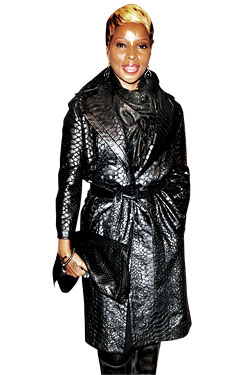
While pop divas are often fashionably late, Mary J. Blige has already ordered her steak when I arrive for our noon lunch at Del Frisco’s in midtown. Wearing diamond-knot earrings, a black top, and boots on that chilly winter day, she shakes my hand firmly while sizing me up.
Blige slides over the leather-bound menu. “I’d suggest you have the rib eye,” she says, digging into a salad. Del Frisco’s, a big swanky palace for red-meat-eating guys in suits, is right across the street from 30 Rock. It’s one of her favorite places. “I can’t remember who invited me here first, but the crab cakes made me fall in love.” She ordered something no longer on the menu—carpet-bagger steak, well done—which the chef agreed to make especially for her.
Born in the Bronx, abused as a child, and raised in Schlobohm Gardens, a Yonkers housing project (aptly nicknamed “Slow Bomb” by residents), Blige, 39, fought her way to fame, and the steakhouse deference that comes with it. Not to mention singing for President Obama on Inauguration Day. Admittedly, she left a trail of drunken chaos and relationship crack-ups in her wake. But in the eighteen years since the release of her triple-platinum debut, What’s the 411, in 1992, her fans have followed her tribulations and self-inflicted sorrows as if they were their own. “I am a work in progress,” explains Blige, who married Kendu Isaacs in 2003 and currently dwells in bucolic, upstanding New Jersey. “And I’m not afraid to let my fans know that.” Actually, that’s exactly what they want to hear. Blige’s shows are often like a revival meeting filled with women, and more than a few men, who feel they know her personally.
Like Oprah, to whom she’s sometimes compared, Blige both embodies and retails a powerful redemptive narrative (albums include No More Drama, 2001; The Breakthrough, 2005; Stronger With Each Tear, 2009). “That doesn’t insult me, because Oprah is like some women’s best girlfriend, and every day at four o’clock they’re knocking on her door to share their joy and problems,” she says. “If that’s how some people feel about my songs, then that’s a good thing.” Last year, Blige opened a women’s center in Yonkers. “As a child, I saw so many women suffer, women who had been beaten. I just wanted to do something that would educate and empower them. There are psychologists there and a day-care center.”
Indeed, it was Blige’s long-suffering pop persona, laced as it is with pain, tears, and salvation, that Lee Daniels, the director of Precious, hoped to tap into when he selected her to contribute the haunting “I Can See in Color” to the film’s soundtrack. The movie left her speechless. “I could not believe the reality of what I had seen,” she says. Daniels’s instructions were to make the music dark. “Not trying to be disgusting, but I knew I had to vomit on the track, meaning I had to give it my all.” As a side note, she says that acid reflux keeps her from overeating, and she in fact doesn’t finish her steak.
“When you’re depressed as a child, you can’t see anything,” continues Blige, who included the song on her new album. “It doesn’t matter if it’s a sunny day, because you’re just pushing through life. I wanted this song to be the music of Precious’s awakening.”
Have good intel? Send tips to intel@nymag.com.